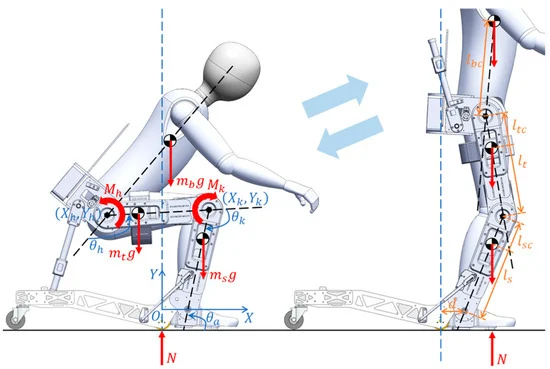
Associate Professor Dr. Ronnapee Chaichaowarat, Faculty of Engineering, Chula, opened the door to his robotics lab, showing the Exoskeleton Wheelchair prototype for the elderly and people with mobility problems so they can leave their wheelchair behind to stand and walk with one robot.
Assoc. Prof. Dr. Ronnapee Chaichawarat, a professor from the International School of Engineering (ISE), Chulalongkorn University, elaborated on the idea of creating a "robotics lab": "This is an alternative solution to education. I created a lab and an environment with tools for students to assemble robots in their spare time from studying. We insist on a "Proof of Concept," which students have to present to a meeting before conducting their experiment prior to testing the innovation with actual users."
Assoc. Prof. Dr. Ronnapee ChaichaowaratTrying on the Exoskeleton wheelchair
"I wanted to create a wheelchair that could walk. An ordinary wheelchair can only move on a regular path, but it cannot get on the bus or go up and down the stairs. So my view is that if a wheelchair could be folded up and help the person sitting in it to get up and walk, it would make it easier for people with reduced mobility to walk," Assoc. Prof. Dr. Ronaphee said of the inspiration for the innovation, which can be considered the world's first exoskeleton wheelchair robot built by Thai people.
This robot was funded by the National Research Council of Thailand (NRCT) in 2021-2022 and most recently was among the finalists in the 2024 Young Technologists Award program organized by the Foundation for the Promotion of Science and Technology Under the Royal Patronage of His Majesty the King.
What is the Exoskeleton Wheelchair Robot?Assoc. Prof. Dr. Ronnapee said that Exoskeleton Wheelchair is a robot worn on the body to help human movement. It can serve as both a wheelchair and be converted into a robot.
"The name Exoskeleton comes from two words: Exo, meaning outside, and Skeleton. "In a way, the idea is similar to Iron Man, which, when worn, gives the wearer more strength. Technically, it is a mechanical assembly of robots that allows the wearer to exert more strength."
From the aforementioned concept, Assoc. Prof. Dr. Ronnapee designed every part of the robot in detail using 3D CAD software, purchased material, and built parts with his in-house machine facilities. Carbon fiber is his material of choice because of its light weight and can be fabricated by 3D printers. Some parts are cut by a CNC (Computer Numerical Control) router machine.
After all the parts have been produced, they are assembled into a robot. Next, it is a matter of motion control, which is divided into 2 parts. The first part is the wheels, which have a group of students programming the front wheel speeds to make the robot traveling straight or turning. The second part is the hip and knee joint motors' control, which is programmed by Assoc. Prof. Ronnapee himself.
"This is a new type of hybrid robot that combines a wheelchair and an exoskeleton. The lower leg can change mode between sitting and walking using a motor to help with the movement of the hip and knee joints. The ankle joint is a free joint with no drive. The left and right wheels can be retracted to the lower leg area to transform into a walking posture or get over obstacles." Assoc. Prof. Dr. Ronnapee explains.
Integration of Mechanics and Human AnatomyAssoc. Prof. Dr. Ronnapee combines his knowledge in engineering, robotics, and human anatomy into the prototype Exoskeleton Wheelchair.
"The design of exoskeleton robots must take into account the ergonomics of the wearer's body and the robot so that it should not overstretch or shrink too much, nor should it cause skin irritation. Every time the legs swing, so should the exoskeleton. When the knees are bent, the knees of the robot must be bent at the same time," Assoc. Prof. Ronnapee explained the challenge.
Exoskeleton Wheelchair Concept Design"We use Kinematics Compatibility in the design with linkage knee joints so that the motion of the rotational center can mimic the actual bone. For the joints supporting lots of leg bending and flexion, we use a four-bar linkage to allow the pivot point to change with the joint."
In addition, Assoc. Prof. Dr. Ronnapee applies his knowledge of Biomechanics to calculate the torque generated from around the ankles, knees, and hips to create robots that fit a person's physiology.
In terms of aesthetics, architectural knowledge is needed to help design the robot, and when the robot is put into practice, the Allied Science Department will need to help guide the elderly and patients.
Assoc. Prof. Dr. Ronnapee is currently developing the second prototype of the Exoskeleton Wheelchair robot, which improves the stability in sitting, getting up, and walking. The application for an intellectual property patent is in progress. The next step will be an actual test with patients and the elderly.
Read the full article at https://www.chula.ac.th/en/highlight/218151/
"Chulalongkorn University sets the standard as a university of
innovations for society and is listed in the World's Top 100 Universities for Academic Reputation, in the Quacquarelli Symonds (QS) World University Rankings 2021-2022."